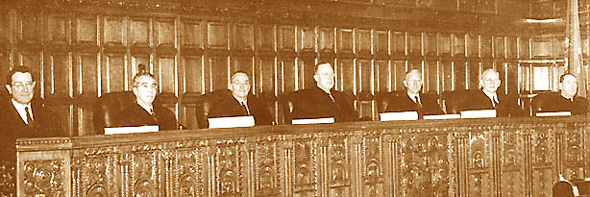|
"Although the U.S. Court of Appeals, 2nd Circuit, held the writ of habeas corpus must issue to codefendant Wade, our reading of the record leads us to conclude that the statement given by Kiernan was not, as a matter of law, the product of coercion.. . ."
New York State Court of Appeals
PEOPLE of the State of New York,
Respondent,
- V.
Edward J. KIERNAN,
Appellant.
[Opinion by Judge Charles W. Froessel for the court:]
About 18 years ago, on June 27, 1941, defendant and three others were convicted of murder in the first degree for the killing of a Sing Sing Prison guard in the course of an escape.
_
 |
|
6 N.Y.2d 274
PEOPLE of the State of New York,
Respondent,
- V.
Edward J. KIERNAN,
Appellant
Court of Appeals of New York.
July 8, 1959.
C. Joseph Hallinan, Jr., New York City,
for appellant.
Joseph F. Gagliardi, Dist. Atty., White
Plains (Douglas L. McGuire, Asst. Dist.
Atty., White Plains, of counsel), for re-
spondent.
FROESSEL, Judge.
|
|
Defendant Kiernan and one Wade were sentenced to life imprisonment, pursuant to a jury recommendation of mercy. Two other defendants, Riordan and McGale, were sentenced to death and
paid the extreme penalty.
The convictions of these other defendants were affirmed . . .
Kiernan filed a timely notice of appeal but did nothing further until Wade in 1958 secured his release by way of a writ of habeas corpus from the United States Court of Appeals, Second Circuit, United States cx rel.Wade v. Jackson, 256 F.2d 7, certiorari denied 357 U.S. 908, 78 S.Ct. 1152, 2 LEd. 2d 1158, on the ground that Wade’s confession was involuntary as a matter of law, and thus its use was in violation of due process of law guaranteed by the Fourteenth Amendment.
Kiernan now presses his appeal and his sole claim is “that the statement ‘extracted’ from him was a coerced confession and its subsequent use as evidence against him at his trial was a denial of due process under the Fourteenth Amendment to the United State Constitution,” and that “In the interest of justice, [hej ought to receive a new trial with his
alleged confession excluded.”
Although the United States Court of Appeals, Second Circuit, has held that the writ of habeas corpus must issue to his codefendant Wade, our reading of the record leads us to conclude that the statement given by the defendant Kiernan was not, as a matter of law, the product of coercion.
| The Relevance of Remembering
What is the relevance of revisiting in 2005 the deadly 1941 Sing Sing escape?
Remembering Correction involves hope of remorse, reform, and reconciliation is always relevant.
Remembering the service and sacrifice of officers killed in the line of duty is always relevant.
Remembering authorities' duty to stay within limits the law imposes on power conferred is always relevant.
---- ---- ---- ------ ------ ----- ----- ---- ---- --- NYCHS webmaster.
|
|
When the so-called “undisputed facts” and “inadequate explanations,” from which the
Federal court concluded that Wade’s statements were coerced, are examined and analyzed in the light of all the evidence in the record affecting Kiernan, they are by no means so conclusive as to mandate a trial court to reject Kiernan’s confession without submission to a jury.
Kiernan, unlike Wade, did not take the stand and testify as to the manner in which he was treated between the time of his arrest and the time his statement was taken.
We do not regard the evidence as to the circumstances surrounding his confession sufficient to
hold that his confession was involuntary as a matter of law, and the use thereof as evidence a denial of due process under the Fourteenth Amendment to the Constitution of the United States.
The judgment of Conviction should be affirmed.
CONWAY, C. J., and DESMOND, DYE, FULD, VAN VOORHIS and BURKE, JJ., concur.
Judgment affirmed.
_
 |
|
New York State Court of Appeals 1959
The above image derives from Page 5 of the 14-page printed program for The Rededication of the Court of Appeals building ceremonies in Albany Oct. 5th, 1959, shows from left: Judge John Van Voorhis, Judge Stanley H. Fuld, Judge Charles S. Desmond, Chief Judge Albert Conway, Judge Marvin R. Dye, Charles W. Froessel, and Judge Adrian P. Burke.
Three months later they -- the judges of the state's highest court -- unanimously affirmed Kiernan's conviction.
Click the cropped sepia version above to access the larger b&w original and the entire printed program on the fine web site of the Historical Society of the Courts of the State of New York.
|
|
|

